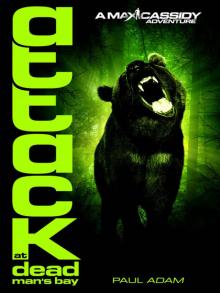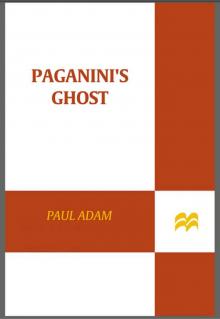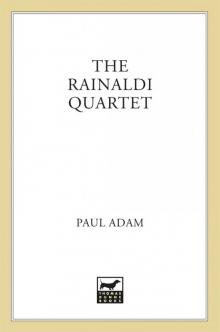Paganini's Ghost Read online
Paganini’s Ghost
ALSO BY PAUL ADAM
The Rainaldi Quartet
Oracle Lake
Knife Edge
Enemy Within
Genesis II
Shadow Chasers
Unholy Trinity
Paganini’s Ghost
PAUL ADAM
Minotaur Books
New York
This is a work of fiction. All of the characters, organizations, and events portrayed in this novel are either products of the author’s imagination or are used fictitiously.
A THOMAS DUNNE BOOK FOR MINOTAUR BOOKS.
An imprint of St. Martin’s Publishing Group.
PAGANINI’S GHOST. Copyright © 2009 by Paul Adam. All rights reserved. Printed in the United States of America. For information, address St. Martin’s Press, 175 Fifth Avenue, New York, N.Y. 10010.
www.thomasdunnebooks.com
www.minotaurbooks.com
Library of Congress Cataloging-in-Publication Data
Adam, Paul, 1958–
Paganini’s ghost / Paul Adam. — 1st ed.
p. cm.
ISBN 978-0-312-38385-5
1. Art dealers—Crimes against—Fiction. 2. Music—Competitions—Fiction.
3. Paganini, Nicolò, 1782–1840—Influence—Fiction. 4. Violin makers—Italy—Fiction. 5. Murder—Investigation—Fiction. I. Title.
PR6051.D3156P34 2010
823'.914 —dc22
2009034524
First Edition: January 2010
10 9 8 7 6 5 4 3 2 1
Paganini’s Ghost
Contents
Chapter One
Chapter Two
Chapter Three
Chapter Four
Chapter Five
Chapter Six
Chapter Seven
Chapter Eight
Chapter Nine
Chapter Ten
Chapter Eleven
Chapter Twelve
Chapter Thirteen
Chapter Fourteen
Chapter Fifteen
Chapter Sixteen
Chapter Seventeen
Chapter Eighteen
Chapter Nineteen
One
Over the half a century that I have been working as a violin maker and repairer, I have had instruments brought to me in many different ways. Most were nothing out of the ordinary—a musician simply turning up at my workshop with a violin in a case—but one or two have been more remarkable.
There was the Guadagnini, discovered under a pile of wooden crates in a hayloft near Bergamo, that was delivered to me wrapped in newspaper and an old potato sack. Then there was the famous, but decidedly eccentric, international virtuoso, whom discretion forbids me from naming, who showed up on my doorstep one day with his Stradivari nestling in the bottom of a supermarket carrier bag. Perhaps most extraordinary of all was the Amati belonging to a well-known Italian soloist, which his wife—a neglected, highly strung woman, tired of playing second fiddle to a piece of wood—had smashed over his head during a particularly violent marital argument. The soloist filed an assault charge against his—soon to be ex-—spouse, and several months later the violin, or, rather, the bits of it, being Exhibit A in the prosecution case, were conveyed to me for repair in eight separate police evidence bags.
But none of these events, bizarre though they were, were quite so memorable as the one that was now unfolding before me.
There were six vehicles in the convoy. I had been telephoned half an hour earlier to be given advance warning of its arrival, so I was waiting outside my house when the procession appeared on the horizon, speeding towards me along the road from Cremona. At the front was a blue-and-white police patrol car with its roof light flashing, but its siren mercifully silent—a show of restraint not normally associated with the Italian police. Behind the patrol car was a shiny dark blue Alfa Romeo with tinted windows, followed by a black armoured van like the ones banks use for delivering cash to their branches. Fourth in the line was a red Fiat Bravo, then a silver Mercedes saloon. Bringing up the rear was a second marked police car.
I had never seen anything like it. My home is relatively isolated, a former farmhouse surrounded by fields of maize and potatoes. The nearest house is a good kilometre away. I usually enjoy the privacy the location affords me, but today, for once, I was sorry that I didn’t have any closer neighbours who could share in this curious spectacle. Such an ostentatious convoy seemed wasted on me alone.
The first police car skidded to a halt just past the entrance to the gravel forecourt at the front of my house, the driver indulging a worrying penchant for exhibitionism by braking heavily and slewing his vehicle round so that it blocked the carriageway. Two scruffy uniformed officers climbed out, both sporting the mirror sunglasses, stubble, and institutional truculence that seem to be de rigueur in the Polizia Nazionale.
The two vehicles immediately behind—the Alfa Romeo and the armoured van—turned off the road onto the forecourt and stopped beside me. Two men got out of the Alfa Romeo. They were so similar in appearance that they could have been twins. Their smart black suits, white shirts, and highly polished black shoes were identical. Even their ties, a silvery grey silk with a black diamond pattern, were the same. They were in their late twenties, wearing mirror sunglasses like the police officers, but a class apart in every other respect—sleek, well-fed leopards to the policemen’s mangy alley cats. With their discreet but stylish clothes, their alert manner—heads constantly moving, eyes searching for possible threats—and the walkie-talkies clutched in their hands, they looked like the bodyguards you always see accompanying the U.S. president or other heads of state. And I suppose bodyguards is what they were, only the body they were guarding was made of maple and pine, rather than flesh and blood.
“You are Giovanni Battista Castiglione?” one of them asked me curtly.
I nodded.
“Your workshop is where?”
“Round the back, in the garden,” I said.
“Show me.”
I led him down the side of the house to the old farm smithy that I have converted into my workshop. His companion remained at the front, but the two men kept in contact by walkie-talkie.
“One-storey brick building, set apart from the house,” the bodyguard murmured into his radio. “Garden”—his eyes scanned my lawn and flower beds—“large, open. Good visibility. No perimeter barrier. Fields beyond.” His gaze came back to me. “Let’s see inside.”
He studied the heavy wooden door and sturdy lock approvingly as I opened up the workshop, relaying his findings to his colleague. Then he inspected the interior of the room, checking the windows first before turning his attention to the workbench and cupboards.
“That’s a safe?” he asked, staring at the steel door set into the recess that had once been a hearth.
“Yes.”
“Looks pretty solid.”
“I handle a lot of valuable instruments,” I said.
He prowled round the table in the centre of the room and opened a couple of cupboards warily, as if he were expecting some assailant—presumably a very small one—to leap out and attack him. Then he raised the walkie-talkie to his lips again.
“Okay, it’s secure. I’m coming back now.”
We returned to the front of the house, where a small group of people had gathered—the occupants of the Fiat and the Mercedes, which had been obliged to park on the verge at the side of the road because there was no room for them on the forecourt. A diminutive man in a grey suit and rimless spectacles stepped forward and held out his hand.
“Dottor Castiglione, it’s a pleasure to meet you. I am Enrico Golinelli, assistant curator of antiquities for the city of Genoa.”
I took his hand in mine. His
fingers felt so slight and fragile that I hardly dared squeeze them.
“I apologise for the short notice,” Golinelli went on. “It is most kind of you to help us.”
“Not at all,” I replied. “I’m honoured that you asked me.”
“Nothing like this has ever happened before. I don’t know what it can be. The instrument was checked over thoroughly before it left Genoa. But Signor Ivanov is absolutely sure that . . .” Golinelli paused. “Forgive me, I’m forgetting my manners.”
He turned away from me and gestured at the man and woman standing next to him.
“Allow me to introduce Yevgeny Ivanov, and his mother, Ludmilla Ivanova.”
Ludmilla Ivanova offered me her hand. I didn’t hesitate to clasp it firmly in my own. There was nothing delicate about her fingers, or her grip. There was nothing delicate about any of her, in fact. She was a big woman, tall and statuesque, with thick black hair pulled back and fastened with a clasp at the nape of her neck. She was wearing red high heels and a scarlet-and-black knee-length dress that was perhaps a shade too low-cut for her mature years, but she had the figure, and the confidence, to carry it off. Her build, the strong, determined set of her jaw reminded me of a Wagnerian soprano and I wondered whether she had been an opera singer once. When she spoke, her voice, too, had the powerful resonance of a Brünnhilde.
“Dottore, I’ve heard much about you,” she said in fluent Italian, the words muddied round the edges by her strong Russian accent. “They say you are good, the best luthier in Cremona.”
I inclined my head modestly, but she was not expecting a reply.
“I hope they are right,” she continued. “We are in urgent need of your expertise. Whatever is wrong, you must fix it. My son’s recital is only hours away.”
She glanced at the young man beside her. He gave me a shy nod, then seemed to shrink away, retreating into his mother’s shadow. He was shorter than Ludmilla and much thinner. His face had a gaunt look that was accentuated by his high cheekbones and deep-set dark eyes, and though his shoulders were broad and his bone structure robust, there was so little flesh on him, he appeared painfully emaciated.
“People are expecting to hear this instrument,” Ludmilla said. “Without it, the recital will not be the same. We shall have to cancel.”
“Let us not be premature, signora,” Golinelli said, breaking in quickly. “The problem may be easily solved. I suggest we proceed immediately, if our escort from the insurance company will permit it.”
Golinelli turned to the two bodyguards.
“Gentlemen?”
“Everything appears to be in order,” one of the young men said.
“Then let us get on.”
The bodyguards signalled to the driver of the armoured van, who nodded and put on his crash helmet and thick, padded protective vest before climbing out and walking round to the rear of the vehicle. The rest of us gathered round to watch him open the doors. There were twelve of us—me, the two bodyguards from the insurance company, Ludmilla and Yevgeny Ivanov and a nondescript-looking man whom I took to be their driver, Golinelli, a young woman with a severe academic face who had to be the assistant curator’s assistant, and the four police officers who had strolled over from their cars to see what all the fuss was about.
The insurance company escorts weren’t happy about that. This was their show. They didn’t want the local cops muscling in on it. One of the bodyguards glared at the policemen and said sharply, “You’re supposed to be watching the road.”
The police officers nodded indifferently, their eyes hidden behind their sunglasses, but they didn’t move. They weren’t going to take orders from a civilian in an Armani suit.
“Okay?” the van driver said. His voice was soft, muffled by the Perspex visor of his crash helmet.
The bodyguards took a last look round, scrutinising the forecourt, the road, the fields.
“Okay, go ahead.”
The van driver inserted a key into the lock, turned it, and swung open the heavy armour-plated doors. The watching group—me included—edged forward, necks craning to see into the interior.
It was something of an anticlimax. At first sight, the van appeared empty—just bare walls and a large vacant cavity. Then the eye was drawn down to the floor, to a web of straps and buckles that were holding something in place. In the centre of the web—looking very small and insignificant—was a rather shabby rectangular violin case.
The driver climbed inside the van, unfastened the straps carefully, and picked up the case by its handle. He passed it to one of the insurance company men, lowered himself back down to the ground, then took the case back.
Quietly, without needing to be given instructions, we somehow organised ourselves into a rough line. The bodyguards were at the front, the van driver sandwiched between them; then came Golinelli and the Ivanovs. I was next, just ahead of Golinelli’s assistant and the Ivanovs’ driver. The four police officers clustered at the rear and, like mourners at a funeral, we all processed solemnly round to my workshop.
Everything about the occasion—the policemen, the bodyguards, the armoured van—seemed so over the top that I was almost inclined to laugh. But the precautions were understandable, for this was no ordinary violin we were escorting. This was a Guarneri “del Gesù”—the most valuable, famous Guarneri del Gesù on earth. This was il Cannone—the Cannon—the violin that had belonged to Nicolò Paganini.
Two
No one can be absolutely certain when and how Paganini came by his Guarneri. The experts, who are notoriously loathe to agree with one another about anything, are divided on the matter. But the generally accepted story is that it was in Livorno in 1802. Paganini was staying in the Tuscan city, but without his violin, which he had probably pawned to pay off one of his many gambling debts. He was nineteen at the time and, since breaking with his tyrannical father and leaving home, had been enjoying his newfound freedom in the manner of all young men throughout the ages—with a surfeit of drink, cards, and women. He had not yet acquired the longhaired, cadaverous appearance and the Mephistophelian notoriety that was to come a few years later, but he was already renowned in northern Italy as a violinist of extraordinary talent. The Livornese asked him to give a concert in their city, overcoming his lack of a violin by lending him a Guarneri del Gesù that belonged to a wealthy local merchant named Livron. The merchant was so overwhelmed by Paganini’s playing that he made him a gift of the del Gesù after the recital. It was Paganini who christened the instrument “the Cannon”—because of its powerful, booming tone—and, though he owned other violins during his lifetime, il Cannone was always his favourite, the instrument with a unique place in his heart. When he died, in 1840, Paganini left the del Gesù to his home city of Genoa, where it is kept in a glass display case in the town hall most of the time, emerging only once every two years when the winner of the Premio Paganini international violin competition is permitted to play it as part of the prize.
I have seen the instrument on display in Genoa and once, many years ago, had the privilege of handling it in the workshop of the city’s then conservator of violins, an old friend of mine from my apprentice days in Cremona. But I had never had the responsibility of examining and quite possibly carrying out work on the violin, until now.
It was a daunting prospect. This was a very special instrument. I tried not to think about how much il Cannone was worth. Priceless is how it is usually described, but the insurance company would undoubtedly have quantified that adjective into something a little more tangible. Ten million euros? Twenty million? How do you put a price on a voice, on a sound that can move an audience to tears?
The case was on the bench in front of me. I gazed at it for a long moment without touching it. I was aware of the people round me—the two bodyguards breathing down my neck, the police officers and the others crowding in on all sides, everyone waiting expectantly for a glimpse of the violin. I felt like a physician at a royal birth, about to deliver the heir to the throne with a
throng of idle courtiers looking on.
My fingers trembling slightly, I reached out and unfastened the catches on the case. I paused for a second. My workshop suddenly seemed very cramped and stuffy.
“If you could move back just a fraction,” I said. “I need more room.”
The spectators withdrew, though not very far. In the confines of the small workshop, there was almost nowhere for them to go. I flexed my shoulders, pushing back the young men from the insurance company, who seemed reluctant to be separated from me. Then I lifted the lid of the case. In an instant, everyone was back, pushing and jostling to see the contents. One of the police officers let out a contemptuous snort—as if to say, All that fuss over this?—and turned away. His disappointment was contagious. I sensed the excitement in the room abate, the spectators’ curiosity vanish abruptly. I could almost hear the crash of expectations being dashed.
In a way, I could sympathise with them. Il Cannone is not an obviously attractive violin. In fact, it has an almost scruffy look to it. It is more than 250 years old, of course, which doesn’t help, but it is not just its age that is the problem. We have come to expect our violins to be smooth and perfect, as if their makers had only just finished them. We expect them to have a vivid colour and almost dazzling sheen, but that is not how Guarneri—or Stradivari, for that matter—made them. Eighteenth-century violins did not have a high French polish. To understand an instrument like the Cannon, you must not let your first impressions influence you. You must look below the surface to fully appreciate its qualities; you must study the detail, the craftsmanship, looking for substance as well as style. You must keep your mind open, eliminate preconceptions and prejudices, like an anthropologist travelling to some distant isolated community where the definition of beauty is different from our own.
And the Cannon is a beautiful violin. There is no doubt about that. The colour has faded and the front plate, between the f-holes, is black with impacted rosin, but the back still has a magnificent lustre, a pattern of russet stripes over a glowing gold base that is like gazing at a sunset through a slatted wooden blind.

 Attack at Dead Man's Bay
Attack at Dead Man's Bay Paganini's Ghost
Paganini's Ghost Escape from Shadow Island
Escape from Shadow Island The Rainaldi Quartet
The Rainaldi Quartet Jaws of Death
Jaws of Death